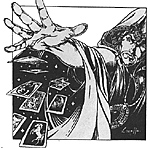 I've been waiting for this game for months.
Last February, when Dark Forest Games
offered to take me along on a trip to see
RAGE (then in late playtest) demonstrated, I jumped at the chance.
I've been waiting for this game for months.
Last February, when Dark Forest Games
offered to take me along on a trip to see
RAGE (then in late playtest) demonstrated, I jumped at the chance.
After the munchies and opening remarks, we were all given prebuilt decks. A double-sided piece of 8 1/2 by 11" paper held the rules and the turn order sheet; we read them over and started playing. At the end of the evening, as we were swapping postmortems and congratulating Dave Williams, the inevitable victor, the consensus was that the game was a winner.
When the final version was I released in May, I jumped on it. Aside from the obvious changes in production, and the occasional fixed card text, the game was remarkably similar to the one I'd played in Berkeley's warehouse. There are three kinds of cards: Characters (e.g. werewolves), which start the game in play; Sept cards, which represent your pack's resources; and Combat cards, which (mostly) deal damage to opposing people, creatures, and giant multinational corporations.
The card layout is functional, if unexciting. Character cards are double-sided, with representations of the shapeshifters in breed (human or wolf) form on one side and Crinos (werewolf) form on the other. Those sept cards which can enhance your werewolves, and the combat cards which mark damage to your wolves, are designed to fit under the character cards in a "T" shape, hiding the art. This is often not a bad thing: while some of the art is very good indeed, most of it is merely serviceable and some pieces are awfully cartoony.
RAGE is very much a combat-oriented game. The goal is to acquire Renown equivalent to your pack's starting Renown. This usually means killing off a pile of enemies or rivals. You can therefore vary the length of the game by agreeing to more or less powerful packs, as well as building in an obvious handicapping system should it be necessary. (Often, it's possible to win the game solely by picking off rival werewolves: this seems darkly similar to the parent RPG, where the Garou often bicker among themselves to the exclusion of fighting the real enemies.)
Although there are political elements to the game, they tend to be combat-related as well. This is, of course, totally appropriate to the genre: RAGE isn't Jyhad any more than Were, wolf: the Apocalypse is Vampire: the Masquerade.
The big innovation is that all players take their turns simultaneously. This makes the game function equally well as a two-player duet or a multi-player brawl. Enemy cards, when attacked, have their defense handled by one of your opponents, so there are few times when anybody is sitting around doing nothing for a long time. If two people wish to defend for the same enemy, it's resolved the same way timing conflicts are - with Rock-Scissors-Paper.
Thanks to the simultaneity and some clever design in the combat system, the game is generally quick to play. The combat system does, however, have a flaw. If I damage your werewolf in combat, I place my combat card under your werewolf. If I kill your werewolf, I place his card in my victory pile. The constant swapping of cards requires eternal vigilance or a pile of markers for each player - and even so, I've managed to lose a couple cards already.
RAGE's other major problem has to be its editing. There are some important errors on the cards themselves (the most infamous example: A Klaive does aggravated damage, but the card lost that text somewhere on the way to the printer), and the rulebook is full of holes. Nag your Net-connected buddy to get you the Frequently Asked Questions list, which fixes almost all of the problems and is very nearly a requirement to play the game. Apparently the players' guide, Savage Attack, is due out soon; it is rumored have a revised and vastly improved version of the rules. I can't recommend it blindly, but it will, at the very least, likely be a good investment for those without a net connection.
The game is quite balanced: although first-turn kills are being discussed online, they're theoretical exercises rather than unbeatable decks. There are a variety of decks available to construct: although combat is the primary theme of most of them, your methods may vary. While broken cards exist, they are few. The ultra-rare foil "chase" cards-there is approximately one per box-are probably technically broken, as most are way overpowered, but they're illegal in tournament play and can therefore probably be banned in friendly play without too many hard feelings. (And if everybody's got one or two, they're a lot of fun.) To sum up: RAGE is one of the better card games on the market, with a flavor and mechanics which are unique to it and whose flaws do not make it unplayable. How can you ask for more?
Back to Shadis #20 Table of Contents
Back to Shadis List of Issues
Back to MagWeb Master List of Magazines
© Copyright 1995 by Alderac Entertainment Group
This article appears in MagWeb (Magazine Web) on the Internet World Wide Web.
Other military history articles and gaming articles are available at http://www.magweb.com